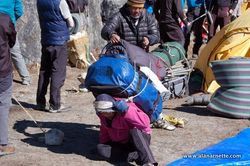
Everest is not the place to save money. There are real costs involved, and you could be putting yourself in danger by skimping. However, with guided expeditions charging from $30K to $100K, figuring out what you should pay can get confusing.
You basically have three ways to climb Everest: put together your own expedition, join a logistics-only expedition, or join a fully-guided expedition. These are your options.
Go it Alone
Theoretically, anyone can fly to Nepal, buy a permit and supplies, hire porters, establish their own camps, pay for use of the fixed ropes, and ferry their own gear. However, even these “independent” expeditions rely on some level of local logistics.
If saving money is the goal, you will be disappointed. Every climber and expedition must pay for a permit, liaison officer, visa, park fee, Icefall route management, fixed ropes, waste deposit, travel, and insurance. Then there is gear, food, tents, oxygen, and sherpa support. Add in and the bill comes out to at least $35K per person for a seven-person team, or $60K for a solo climber.
Below is my estimated breakdown of the main costs. As you'll see, climbing solo is too pricey for most people.
Travel expenses: $2,375 – $6,225
Getting to EBC: $2,150
Climbing fees and deposits: $19,700 – $37,700
EBC equipment and cooks: $9,300
Oxygen and climbing Sherpas: $8,525
Gear: $7,000
Misc (medical kits, communications, evacuation): $8,250-$12,000
Guided Expeditions
The advantage of going on a guided expedition is that you'll be able to split some costs—such as permit fees, deposits, cooks, and tents—across multiple climbers. Commercial expeditions come in three main varieties: Sherpa-supported, Sherpa-guided, and Western-guided.
Sherpa-supported
A Sherpa-supported expedition is one where a company organizes all the logistics: food, group gear, transportation plus Sherpa support but does not provide traditional guides. These cater to experienced climbers, or those on a tight budget. You can sign onto one of these climb for under $30,000 on the south side, but you need to read the fine print.
At the low end of the price range, a Sherpa will ferry your oxygen gear to the highest camps, prepare all the tents, and carry the group gear (but not your personal gear). He will climb with you on summit night, but you are on your own with your teammates throughout the rest of the acclimatization climbing process. It's unlikely you'll have access to modern weather forecasting technology, you may use old-style oxygen masks, and you may even find yourself climbing alone.
Sherpa-guided
A Sherpa-guided expedition will have an experienced Sherpa lead the climb. You may be climbing in a group, risking becoming separated from your team, especially on summit night. This approach varies widely amongst operators, so ask questions in advance to make sure you won't be climbing alone—never a good thing on Everest. In some cases, you may be able to hire a personal Sherpa to climb with you for an extra $5,000 to $7,000, plus tip and bonuses.
Western-guided
Western-guided expeditions are 'full service' trips, and are most appropriate for first-time Everest climbers or anyone looking for a bit more support. The cost varies from $45K to $65K. This includes all the services of a Sherpa-guided climb, plus a western guide for the group. If you want your own personal Western guide, expect to pay $100K, plus tips and bonuses.
The major point of this approach is you are climbing in close proximity to someone who speaks your language and most likely has several summits of Everest under his or her harness. There is no language barrier, and the guide will make all the decisions concerning turn-around times, weather, and emergencies. In addition , you will receive coaching and encouragement, though this varies from guide to guide.
On some expeditions, you will also receive a higher quality of food. One service likes to promote their sushi, another their five-star chef. Some offer espresso machines and open bars. The sky’s the limit, all at a price
So what is the difference between an Everest expedition for $65K and one for $40K? Often, it is simply how many services are bundled into the price. The lowest price outfits promote a low price and then offer “options” such as oxygen, Sherpa support, bonuses, or even food above base camp.
Another common practice to keep expedition costs low is to pay support staff the absolute minimum. It is critical to understand what you are getting into. If you are climbing with a small or thinly-staffed team, there is a possibility that they won't have the resources to help you if you get into trouble. It is a serious and sometime fatal mistake to believe that Everest is so crowded that someone will always be around to give aid if needed. The best operators pay their staff a fair wage.
In the end, if you get references from other climbers of similar age and experience, the decision will be clear for you. The best operators will welcome your questions as well. No guide wants to bring on someone who is a liability, so they are interviewing you as much as you are them.
You can see more of my thoughts on Everest guides on my site at .
Climb On!
Alan
Memories are Everything
Arnette is a speaker, mountaineer and Alzheimer's Advocate. He just completed his 7 Summits Climb for Alzheimer's project to raise $1 million for Alzheimer's research. You can read more on his .